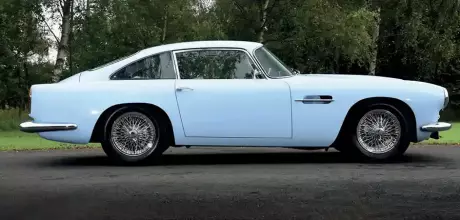1958 Aston Martin DB4 Prototype
As a prototype and one of the earliest known examples, this 1958 DB4 is an incredibly important car in Aston Martin’s long history.
WORDS & PHOTOGRAPHY PAUL WALTON
EARLY START DB4 PROTOTYPE
Produced in 1958, this DB4 was the seventh prototype produced and has many unusual features
If the DB5 is a finished painting by a famous grand master, then this DB4 is the equivalent of some early preliminary sketches. Although not quite the finished article, it’s a close and important representation of what was to come.
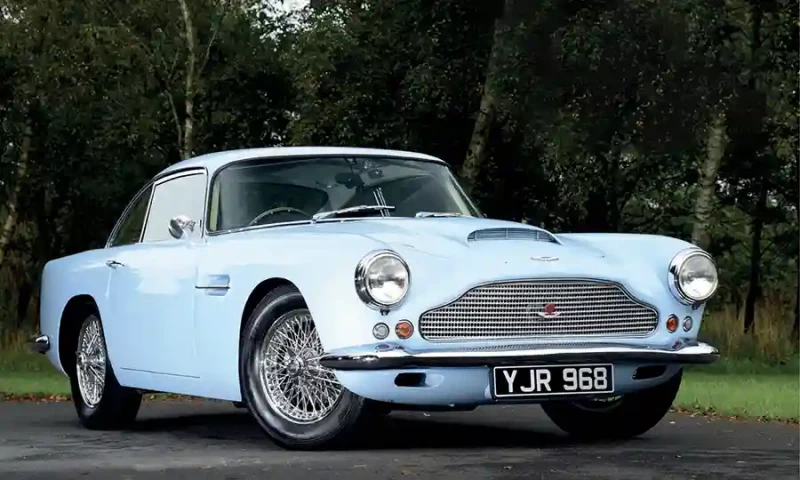
As an early prototype, it not only played a significant role in the DB4’s development but helped to lay down the groundwork for what’s still considered to be Aston Martin’s most famous and iconic car, the DB5.
First registered as 4 SMU on 17 October 1958 to David Brown Industries Ltd, the Wedgewood Blue DB4 with chassis number 107/R was the seventh of 15 prototypes built in the late Fifties to develop Aston’s all-new model.
As well as the many non-standard parts fitted to the chassis that were found when the car was restored in the mid-2000s, it was also later given fully framed door windows plus electric side glass, neither of which the DB4 had until the slightly updated Series 2 arrived in January 1960.
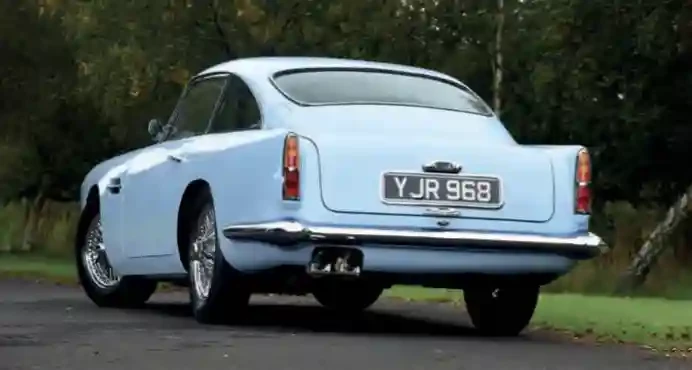
According to the buff-coloured log book, ownership of the car was transferred to Aston Martin Lagonda Ltd in August 1960 when it became a works demonstrator.
The blue car wasn’t the only one of these early prototypes to be used for publicity. Chassis 102/L became the French demonstration car, 105/L was displayed at the 1959 Geneva Show before staying in Switzerland while 106/L was sent to New York. As with the first DB4 made – 101/R – incredibly all of these other early examples have survived. It was as a demonstrator when 107/R made a brief appearance in the 1960 British film Too Hot to Handle. Although fleeting, Jayne Mansfield’s character, Midnight Franklin, can clearly be seen climbing out of the driver’s seat. Insignificant compared to the DB5’s future starring role in several James Bond films but it was proof of both the car and Aston Martin’s growing celebrity status.
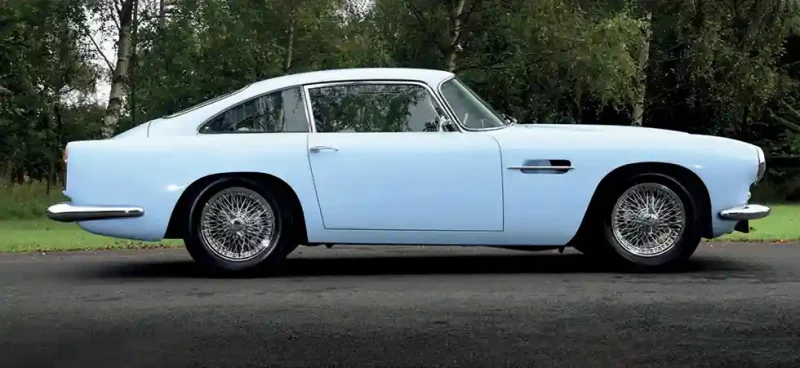
Aston Martin’s chairman, (Sir) David Brown, it said to have also used 107/R during this time. As the first Aston Martin to feature Touring’s lightweight Superleggera construction plus Tadek Marek’s all-new 3.7-litre straight-six engine, which together put the car in the same high-performance league as Ferrari, Maserati and Mercedes-Benz, Brown was always very proud of the model. “The DB4 was a completely new and a very brave and expensive step,” he mused in Geoff Courtney’s 1978 book, The Power Behind Aston Martin.
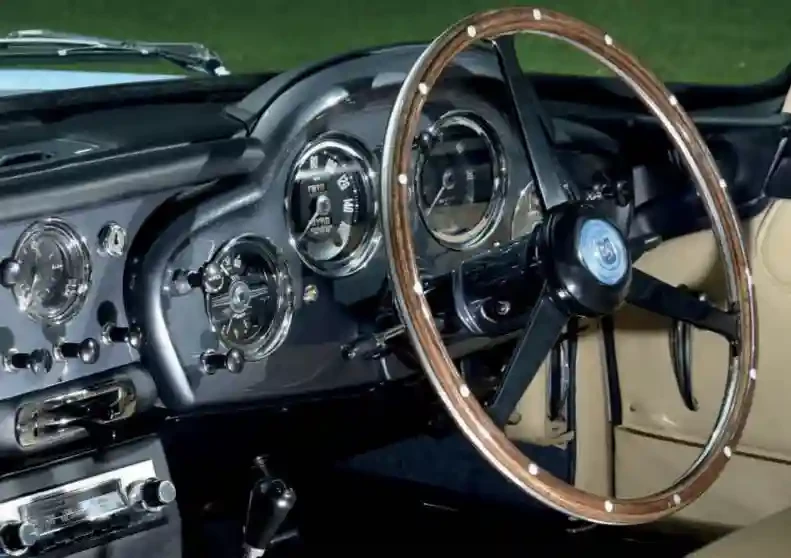
The chairman had first driven a DB4 in mid-1957 when the company’s chief engineer, Harold Beach, had taken the original prototype to Brown’s farm in the Cotswolds for assessment. “The car went really well and Brown was thrilled,” continued Beach in Courtney’s book. “It was fantastic, in a completely different world from the roadholding points of view in particular. When David Brown had finished, he said to me, ‘This is a very promising motor car.’”
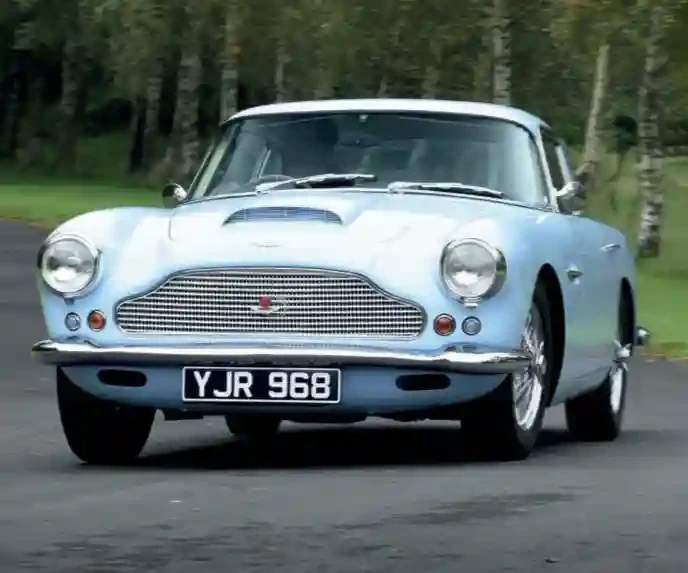
Chassis 107/R was initially fitted with what’s now considered to be the earliest known version of the 3.7-litre straight-six, 370/PP/105 (the PP standing for preproduction). Although diff erent engines were later trialled, when the 107/R was finally sold in February 1961, the original unit was put back and remains in the car. According to the car’s original buff — coloured log book, the next owner was a Jonathan Saul of Workington, Cumberland. He kept the DB4 for five years before selling it in June 1966 to a well-known car dealer, Robson & Everard, based in Gosforth, Newcastle upon Tyne. Saul, though, paid the princely sum of £5 to retain the car’s original and distinctive 4 SMU numberplate, transferring it to an Alfa Romeo (it’s currently on a 2016 Smart FourTwo). The blue DB4 was then given the less memorable YJR 968 instead.

The car’s brief appearance in the 1960 film, Too Hot to Handle. The poor state of the chassis was revealed during its restoration in the mid 2000s. This image was taken During the car’s time as a works demonstrator when it still registered 4 SMU.
When the prototype was sold a few months later, it was to another automobile dealer, Mr Don Carr of Central Garage, North Shields, although it’s believed the car was used for a short time as his personal transport. An invoice from 26 October 1966 reveals it received a full engine rebuild by Aston Martin which cost £590 plus another £39 to have the suspension recommissioned.
The still blue DB4 was next bought in June 1967 by one of Carr’s friends, a local dentist called Raymond Stanger. He used the now nine-year-old car to drive the ten miles between his home in Newcastle and his Tynemouth dental practice. Although living in St Kitts at the time, Raymond’s son, David, bought the car from his father in 1973 for £400, using it whenever he was visiting the UK.
In April 1974, David instructed a Spennymoor-based garage, H. Raine & Sons, to repair several now-rusty areas such as all four wings, the off side jacking point plus the door frames before repainting these areas. The rear bumper was also removed and sent away to be rechromed.
The car received more bodywork repairs in 1987 when it was also given a full metal respray plus further structural work to the chassis. Now living in the UK full time, David drove the DB4 regularly but due to it needing a full restoration, it was placed in storage during the mid-Nineties. Almost 40 years after his father had first bought the car, David sold the DB4 in 2006 to established marque expert Aston Workshop. Although over the years the prototype DB4 had received whatever needed to keep it on the road, it was largely original and therefore retained many of the original features such as the powered windows.
It was only after the car was stripped that the many differences below the surface were found. For example, it was clear that several alternative positions for the Watts linkage had been tried plus other redundant brackets and mounting points were discovered along with numerous superfluous holes that had been later plug-welded or just left unfilled. The car might have been complete but it was in a terrible state. Several areas of the chassis needed to be repaired such as both front outriggers, jacking points and front suspension supports. The complete rear suspension supporting structure also needed replacing as did the legs that lead backwards under the boot floor.
The sills, A- and B-posts, windscreen frame, rear window frame and boot aperture all needed to be replaced. The door frames were also reconstructed and the doors themselves reskinned.
That prototype engine was also rebuilt using as many of the original parts as possible. The gearbox and suspension were then recommissioned. Finally, the seats, door cards, dashboard undertray and radio console were then reupholstered in beige leather.
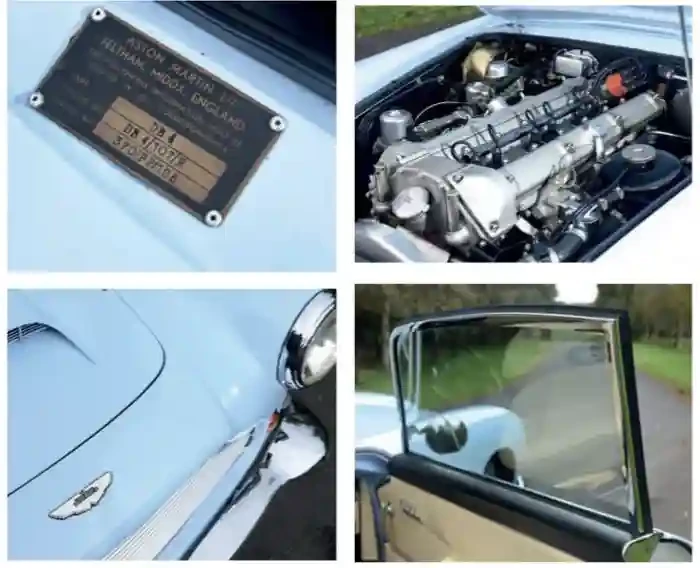
After the body had been repainted in the original Wedgewood Blue, the car was then reassembled in time for the 2007 Pebble Beach Concours d’Elegance before being sold.
Following being with the same local owner for several years, the DB4 is now for sale through Aston Workshop where I’ve travelled to see it. Although its restoration was over 15 years ago, the light blue paint looks as resplendent as the day it was applied, the bright if old-fashioned colour a perfect match for the DB4’s always elegant lines. Together with its unmarked chrome, on the surface it looks to be the perfect example of a standard DB4. Only the door frames and buttons for the electric windows in the door cards set it apart from a standard example. Yet there’s more to the car than its admittedly important status as a pre-production model with a full history. Since the DB5 was a direct development of the DB4, this early prototype helped lay the foundations for one of the most famous cars ever produced. And so, like those preliminary sketches for a grand master painting, without this early DB4 there would be no DB5 as we know it.
Thanks to: Aston Workshop (aston.co.uk)


